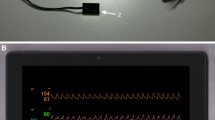Abstract
Objective
To compare values of\(S\bar vO_2 \) obtained by reflectance spectrophotometry continuous monitoring with those obtained from blood samples measurements by transmission spectrophotometry (Co-Oximetry).
Design
Values of\(S\bar vO_2 \) recorded by three pulmonary artery catheters for continuous monitoring, SAT 1, SAT 2 and Oximetrix 3 (OX 3), were compared in a prospective manner to those measured on blood samples by a Co-Oximeter, using the statistical analyis of Bland and Altman.
Setting
Adult intensive care unit in an University Hospital.
Patients
37 patients admitted for acute respiratory failure and/or shock who required hemodynamic monitoring.
Main results
The bias (average under- or overestimation) was small for all comparative measurements: +1.3, −0.2 and +1.0 sat% for SAT 1, SAT 2 and OX 3, respectively. However, limits of agreement were only acceptable for SAT 2 (−8.3 to +7.9 sat%) and OX 3 (−6.7 to +8.6 sat%), but not for SAT 1 (−23.3 to +25.9 sat%). No significant drift during 24 h was found with the three catheters. However, in vitro calibration was only found acceptable for SAT 2 and OX 3. The results were not influenced by the numbers of wavelengths of the device (2 for SAT 1 and SAT 2, and 3 for OX 3) nor did they correlate with any of the hemodynamic and biochemical variables tested.
Conclusion
For usual monitoring in the ICU, SAT 2 and OX 3, gave\(S\bar vO_2 \) values which are in acceptable agreement with\(S\bar vO_2 \) measured on blood samples by Co-Oximetry.
Similar content being viewed by others
References
Enson Y, Briscoe WA, Polavni ML, Gournand A (1962) In vivo studies with an intravascular and intracardiac reflexion oximeter. J Appl Physiol 17:552–558
Taylor JB, Lown B, Polavni ML (1972) In vivo monitoring with a fiberoptic catheter. JAMA 221:667–673
Cole JS, Martin WE, Cheung PW, Johnson CC (1972) Clinical studies with a solid state fiberoptic oximeter. Am J Cardiol 29: 383–388
Krauss XH, Verdouw PD, Huggenholtz PG, Naura J (1975) On-line monitoring of mixed venous oxygen saturation after cardiothoracic surgery. Thorax 30:636–643
Nelson LD (1987) Mixed venous oximetry. In: Snyder JV, Pinsky MR (eds) Oxygen transport in the critically ill. Year Book Medical Publishers, Chicago, pp 235–248
Gettinger A, Detraglia MC, Glass D (1987) In vivo comparison of two mixed venous saturation catheters. Anesthesiology 66:373–375
Reinhart K, Moser N, Rudolph T, Bredle D, Sprecht M, Gram HJ, Goecke J, Eyrich K (1988) Accuracy of two mixed venous saturation catheters during long term use in critically ill patients. Anesthesiology 69:769–773
Rouby JJ, Poete P, Bodin L, Bourgeois JL, Athaud M, Viars P (1990) Three mixed venous saturation catheters in patients with circulatory shock and respiratory failure. Chest 98:954–958
Karis JH, Lumb PD (1988) Clinical evaluation of the Edwards laboratories and oximetrix mixed venous oxygen saturation catheters. J Cardiothorac Anesth 2:440–444
Hecker BR, Brown DL, Wilson D (1989) A comparison of two pulmonary artery mixed venous oxygen saturation catheters during the changing condition of cardiac surgery. J Cardiothorac Anesth 3:269–275
Ponds CG, Blessios G, Bowlin BS, McCawley C, Lappas DG (1992) Perioperative evaluation of a new mixed venous oxygen saturation catheter in cardiac surgery patients. J Card Surg Vasc Anest 6: 280–282
La Manthia KR, O'Connor T, Barash PG (1990) Comparing methods of measurement: an alternative approach. Anesthesiology 72:781–783
Westgard JO, Hunt MR (1973) Use and interpretation for common statistical tests in method comparison studies. Clin Chem 19:49–57
Altman DG, Bland JM (1973) Measurement in medicine: The analysis of method comparison studies. Statistician 32:307–317
Landsmann MLJ, Knop N, Mook GA, Zilgistra WG (1978) A fiberoptic reflexion oximeter. Pflügers Arch 373:273–282
Scuderi PE, Bowton DL, Meredith JW, Harris RN, Evans JB, Anderson RL (1992) A comparison of three pulmonary artery oximetry catheters in intensive care unit patients. Chest 102:896–905
Shegal LR, Sehgal HL, Rosen AL, Gould SA, Moss GS (1984) Effects of intralipid on measurements of total hemoglobin and oxyhemoglobin in whole blood. Crit Care Med 12:907–909
Suter PM, Lindauer JM, Fairley HB, Schlobohm RM (1975) Errors in data derived from pulmonary artery blood gas values. Crit Care Med 3:175
Fox MJ, Brody JS, Wentraub LR (1979) Leucocyte larcency: a cause of spurious hypoxemia. Am J Med 67:742–746
Rouby JJ (1991) Continuous\(S\bar vO_2 \) monitoring using fiberoptic Swan-Ganz catheters in the mechanically ventilated patient. In: Vincent JL (ed) Update in intensive care and emergency medicine. Springer, Berlin Heidelberg New York Tokyo, pp 86–96
Mook GA, Osypka P, Strum RE, Wood EH (1968) Fiberoptic reflexion photometry on blood. Cardiovasc Res 2:199–209
Author information
Authors and Affiliations
Rights and permissions
About this article
Cite this article
Armaganidis, A., Dhainaut, J.F., Billard, J.L. et al. Accuracy assessment for three fiberoptic pulmonary artery catheters for\(S\bar vO_2 \) monitoring. Intensive Care Med 20, 484–488 (1994). https://doi.org/10.1007/BF01711900
Received:
Accepted:
Issue Date:
DOI: https://doi.org/10.1007/BF01711900




